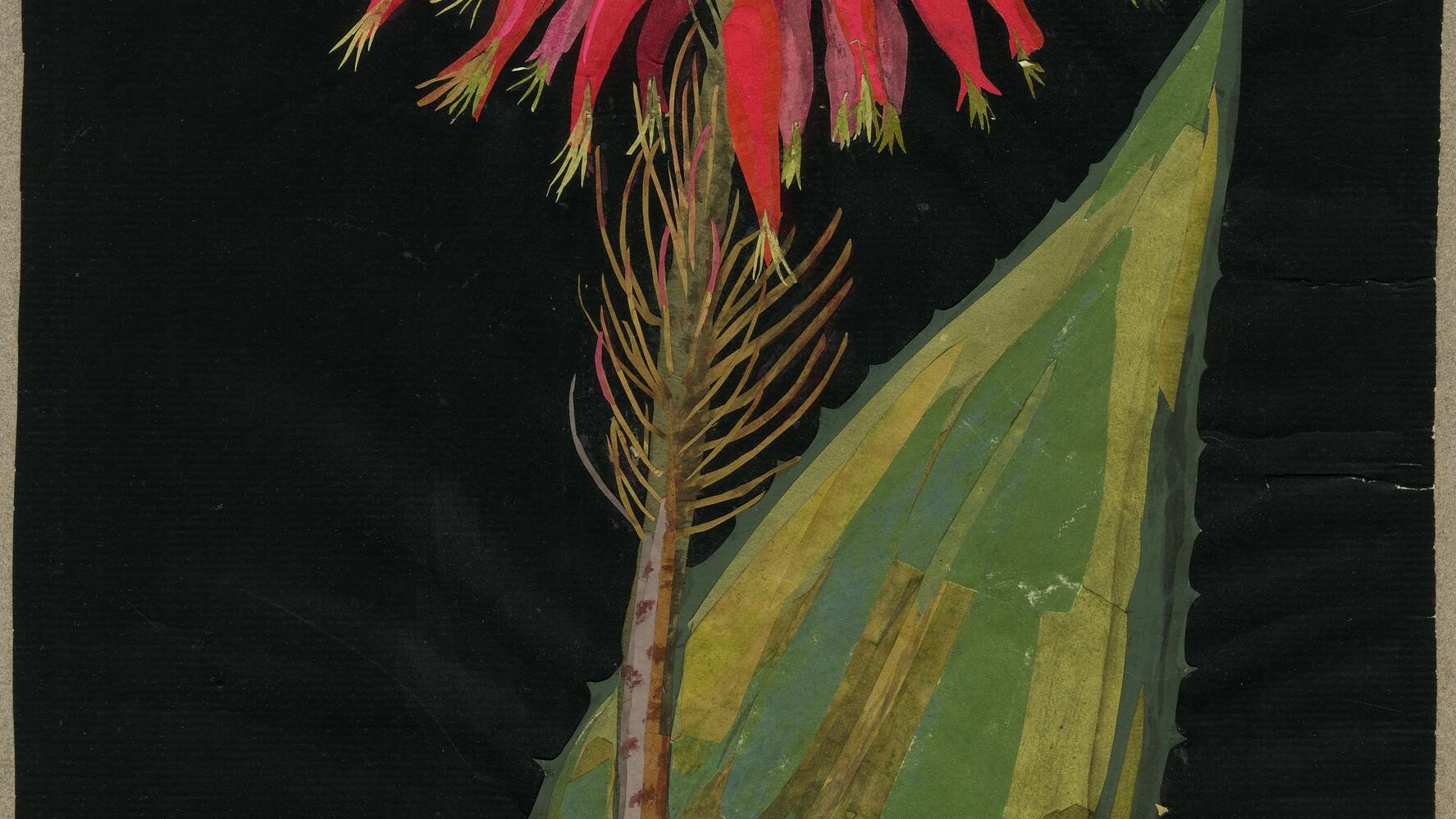Finding inspiration in the Garden: Botanical art and aloes at Chelsea Physic Garden
By Eve Barro, Assistant Project Curator at Chelsea Physic Garden
Every month, we will be labelling the plants mentioned in these blogs to bring our stories to life, so keep an eye out for the circular green labels during your next visit. A full list of these plants can be found at the end of the blog.
We are celebrating botanical art and aloes in this month’s blog post through six amazing artists who depicted our spiky specimens. Aloes have been part of the Garden’s identity for a very long time. In fact, we know of aloes being grown in the stove house at Chelsea Physic Garden as early as 1706! The introduction of these plants inspired many artists who used our specimens in their work, showcasing their horticultural relevance, medicinal use, and beauty.
John Haynes (1706-1770)
British engraver, copper-plate printer and land surveyor John Haynes represented Chelsea Physic Garden’s aloes in his work. As part of his land surveying practice, he produced maps including a plan of Chelsea Physic Garden dated from 1751 which he named “An accurate survey of the Botanic Gardens at Chelsea with the Elevation and Ichnography of the Green House and Stoves and an explanation of the several Parts of the Garden showing where the most conspicuous Trees and Plants are Disposed. The whole Carefully survey’d and delineated by John Haynes” (1). The map incorporated important features of the Garden such as the statue of Sir Hans Sloane and the four cedars of Lebanon brought from Leiden botanical garden in 1684. An aloe features on each side of the map. The aloes represented are Aloe humilis on the right-hand side and Aloe arborescens on the left-hand side, two species that were first cultivated in the UK by Head Gardener Philip Miller (1691-1771) (2,3).
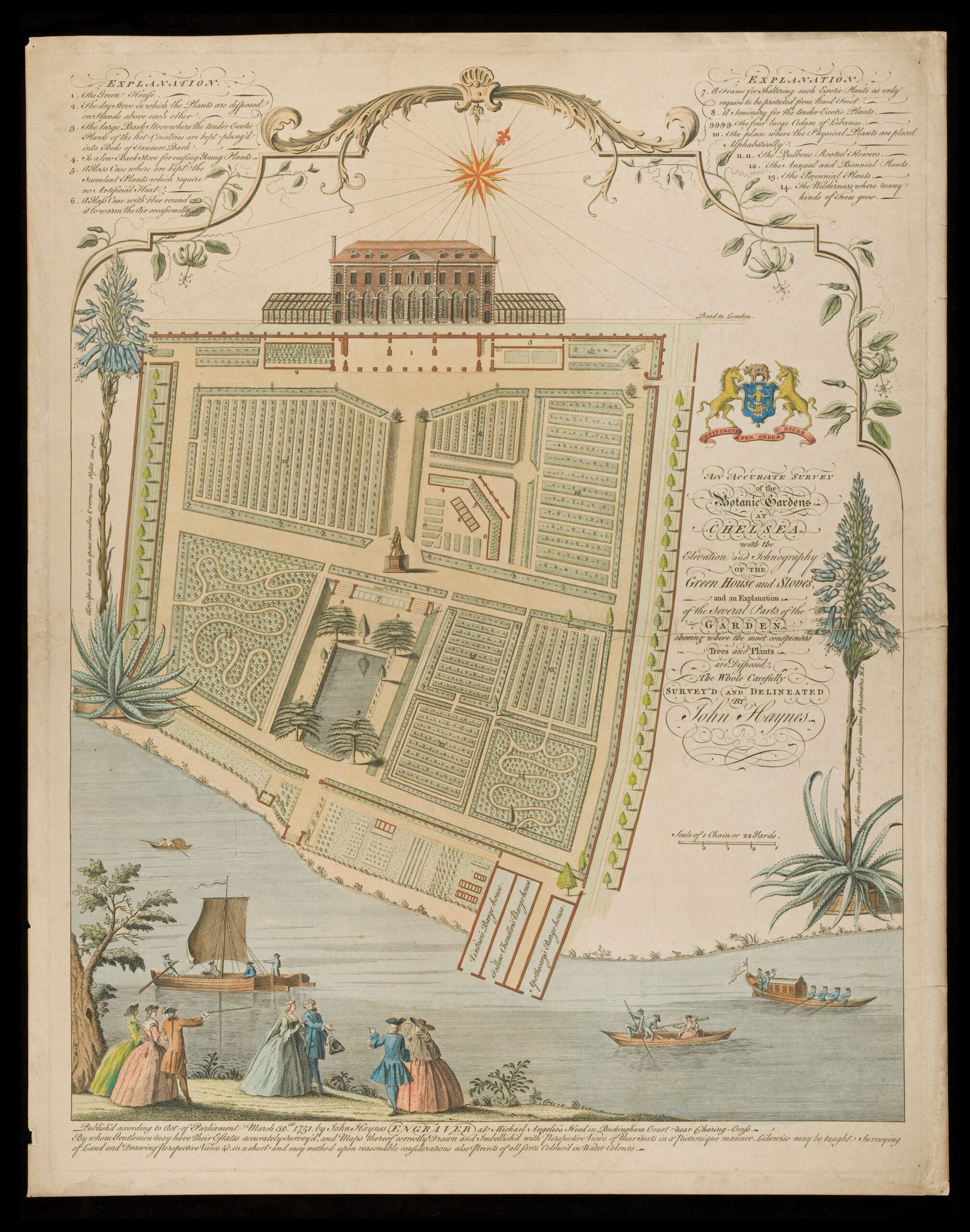
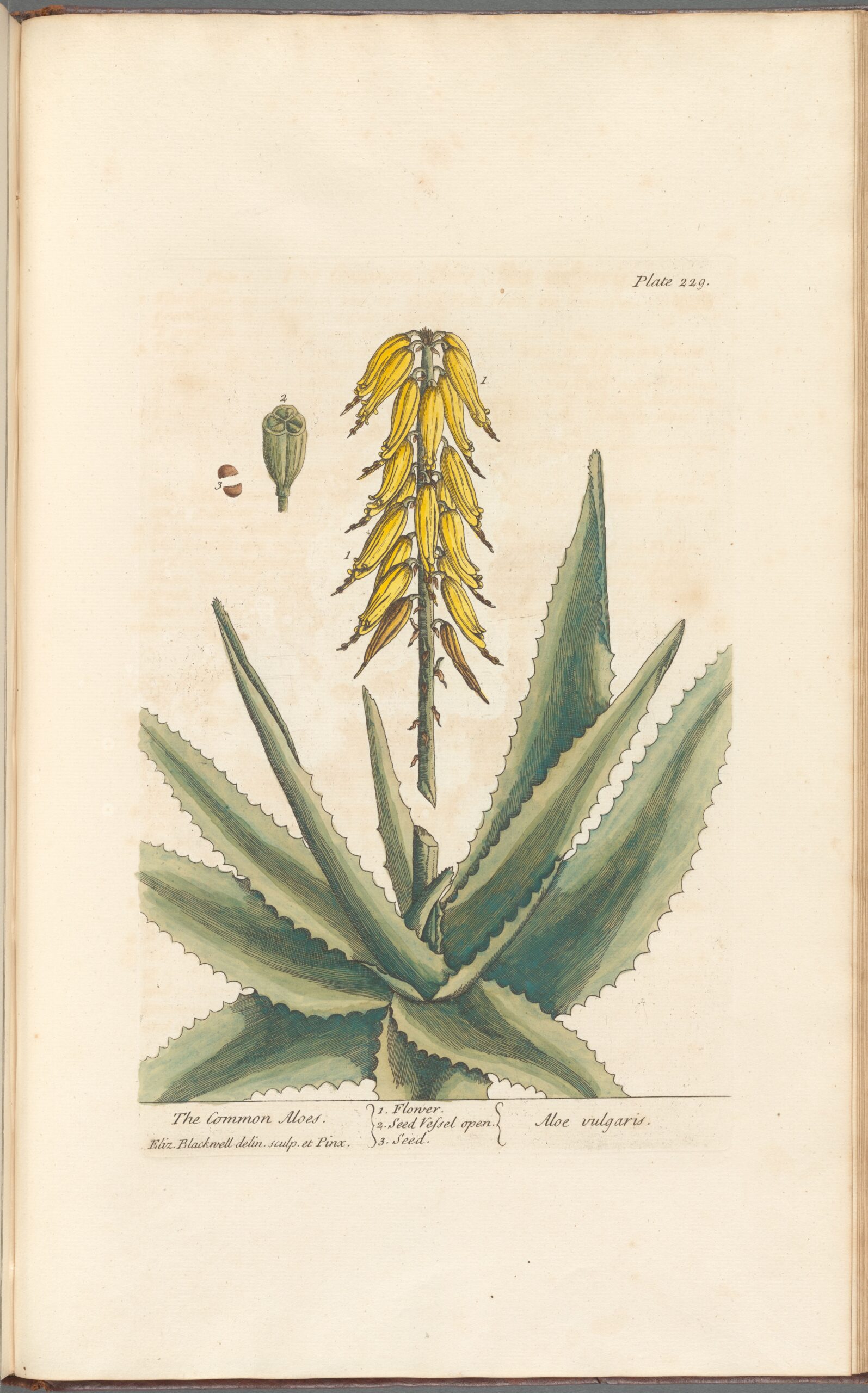
Elizabeth Blackwell (1707-1758)
In 1737, Elizabeth Blackwell (1707-1758) became the first woman to publish a printed herbal. Two of our aloes featured in her Curious Herbal Containing five hundred cuts of the most useful plants which are now used in the practice of physick: Aloe vera (plate 229) and Aloe succotrina (plate 333). In this book, supported by several members of the Worshipful Society of Apothecaries of London, she drew, etched, engraved and hand-coloured plants from Chelsea Physic Garden. She annotated each illustration with information on the plant’s native range, common names, and medicinal use. She noted the use of aloes to heal wounds and as a purgative and produced illustrations of the plants with detailed leaves and flowers. Her work united artistic representation and medicinal knowledge, celebrating the beauty and usefulness of plants. Her botanical illustrations were also a way to accurately describe plant anatomy without requiring lengthy text-based descriptions, making it more accessible to lay readers (4).
Anna Maria Garthwaite (1688-1763)
Anna Maria Garthwaite took inspiration from Chelsea Physic Garden’s aloes for her silk designs. Anna Maria Garthwaite was a very prolific and successful silk designer based in Spitalfields, London. At the time, London was renowned for the production of flowered silks that would be used to make garments. In her designs, she very often showcased her interest in blending English native flora with “curious” and “exotic” plants, such as aloes, that circulated through the British Empire (5). The younger brother of her sister’s husband was the British apothecary and botanist Vincent Bacon. He was a member of the Worshipful Society of Apothecaries of London and gave Anna Maria Garthwaite access to Chelsea Physic Garden. During her visits, she sketched various plants including our aloes. She used her craft to playfully experiment with botany. In one of her designs, she combined a rose, a quintessential English garden flower, and a spiky aloe, mimicking the level of details and accuracy of contemporary botanical illustrations.
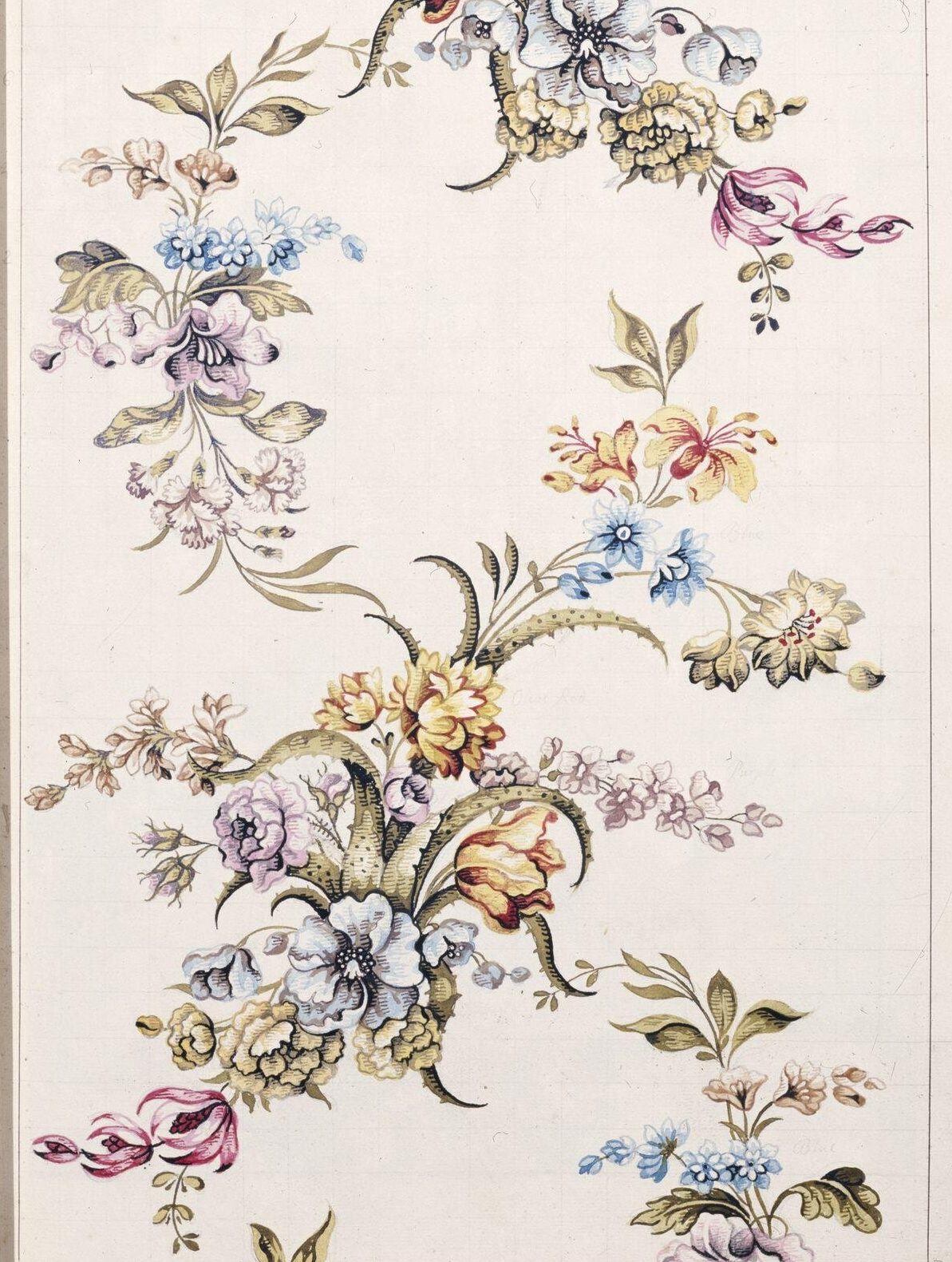
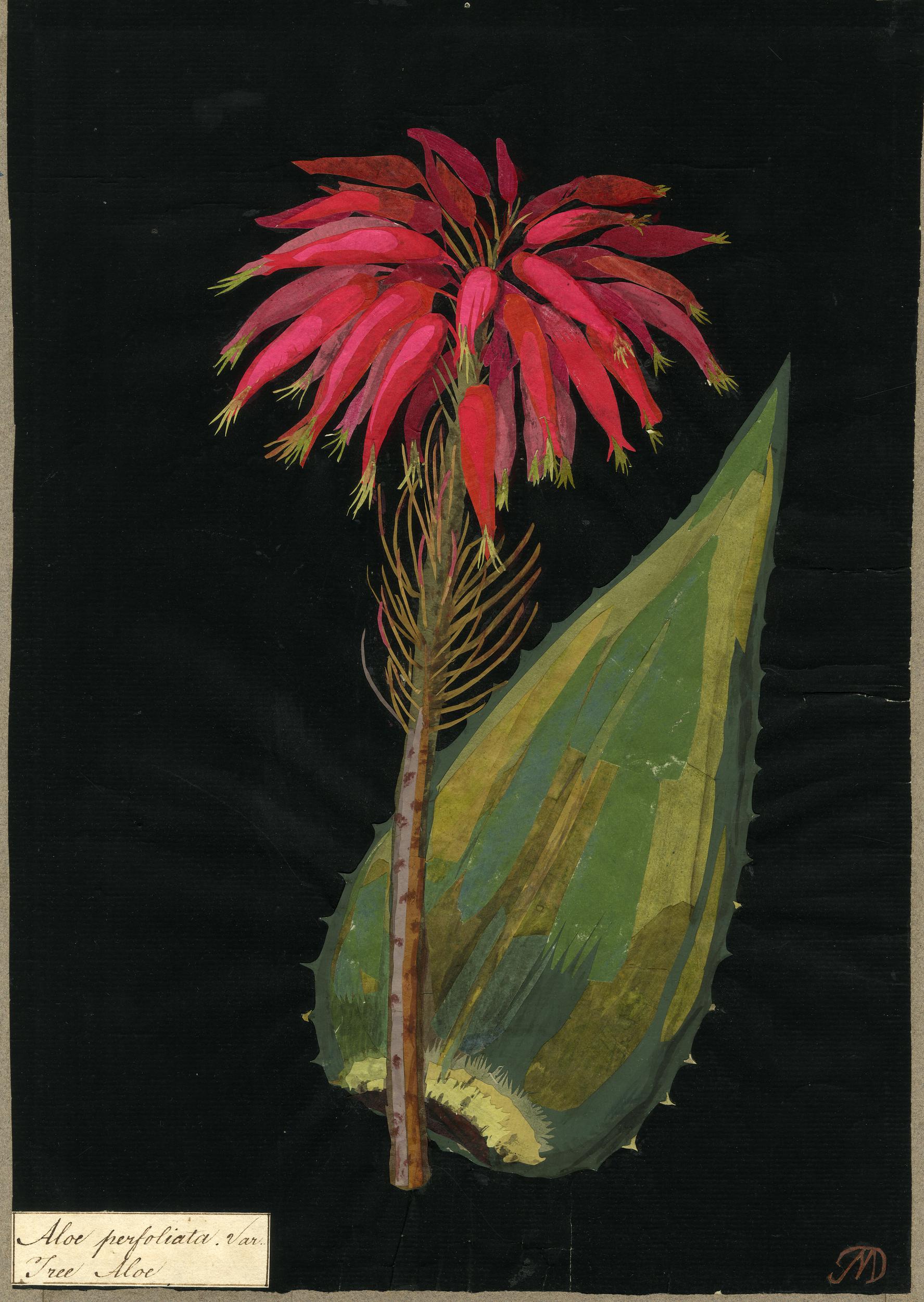
Mary Delany (1700-1788)
Garden designer and botanical artist Mary Delany regularly used Chelsea Physic Garden’s specimens to produce botanical illustrations. Mary Delany is renowned for her mastery of paper mosaics, a type of paper cutting and collage that she invented. At least eight out of the 985 collages that she made were of specimens supplied by Chelsea Physic Garden, including Aloe perfoliata. Sir Joseph Banks considered her work to be so detailed and accurate that, from it, he would “venture to describe botanically any plant without the least fear of committing an error” (6). Each plant in the Flora Delanica, her collection of paper “mosaicks”, was represented with scientific accuracy and labelled with the plant’s Linnean and common names, its collection number and date of creation. Her work defied the gendered boundaries of botanical classification which were deemed “unladylike” at the time as it was based on plant sexual reproduction (7).
Jacob van Huysum (1688-1740)
Jacob van Huysum produced several commissioned illustrations of Chelsea Physic Garden’s aloes. The idea of using botanical illustrations to record plants from the Garden was initiated by Taylor White Esq who showcased Jacob Van Huysum’s work before members of the Royal Society in 1734, proposing it as a way to preserve the specimens that Chelsea Physic Garden was supplying yearly. The president of the Royal Society’s council opined that “it might not be amiss to preserve copies of some of the rarer or choicer plants after this manner”. Miller subsequently proposed that the collection of aloes be preserved in this way and the Dutch artist was asked to supply them in collaboration with German botanical artist Georg Dionysius Ehret. Jacob Van Huysum produced 5 different illustrations of our aloes including of Aloe humilis and Aloe arborescens. Isaac Rand (1674-1743), first Horti Praefectus et Praelector Botanicus Chelseiani (Director and Lecturer in Botany at Chelsea Physic Garden), appreciated his work very much and said his illustrations were “exactly designed after life” with “great Accuracy and Success” (8).
Georg Dionysius Ehret (1708-1770)
Georg Dionysius Ehret collaborated with Jacob van Huysum to yield illustrations of our aloes for the Royal Society. In fact, Chelsea Physic Garden’s plants were one of Ehret’s preferred sources of inspiration. He became so associated with Chelsea Physic Garden that he started giving his address simply as “Mr Ehret, painter at the Physick Garden, Chelsea, near London”. The German artist’s arrival in London in 1735 coincided with the moment when the Royal Society advised that paintings to be made of Chelsea Physic Garden’s aloes. Miller initially asked Ehret to paint three species of aloe and showcased them to the Royal Society’s council who “much approved” of them (8). Ehret then proceeded to produce 22 different paintings of our aloes including Aloe arborescens. The reason Miller recorded aloes using this method was because their succulence made it difficult to create good herbarium specimens. In fact, there are no aloes in the collection of 3,750 dried plants sent to the Royal Society between 1722 and 1796 (2).
Find the plants mentioned in this post during your next visit of the Garden!
Plant 1: Aloe arborescens
Plant 2: Aloe vera
Want to know more?
Anishanslin, Z. (2016). Portrait of a woman in silk: Hidden histories of the British Atlantic world. Yale University Press.
Hessel, K. (2022). The story of art without men. Hutchinson Heinemann.
BOTANICAL ART & ARTISTS. (n.d.). Introducing Georg Dionysius Ehret (1708-1770)—Botanical Artist. BOTANICAL ART & ARTISTS. Retrieved 13 April 2023, from https://www.botanicalartandartists.com/about-georg-ehret.html
References
1- Alexander, D. (2023). John haynes. British Museum.
2- Stungo, R. (1996). Recording the aloes at chelsea. A singular solution to a difficult problem. Notes and Records of the Royal Society of London, 50(1), 47–57.
3- Le Rougetel, H. (1998). Philip Miller: Great gardener of the eighteenth century. Chelsea Physic Garden Company.
4- Stiles Tyson, J. (2021). Sourcing a curious herbal. Herbal History Research Network.
5- Anishanslin, Z. (2016). Portrait of a woman in silk: Hidden histories of the British Atlantic world. Yale University Press.
6- Delany. (2011). Autobiography and correspondence of mary granville, mrs delany: With interesting reminiscences of king george the third and queen charlotte. Vol. 3 (A. H. Llanover, Ed.). Cambridge University Press.
7- Moore, L. L. (2011). Sister arts: The erotics of lesbian landscapes. University of Minnesota Press.
8- Hunting, P. (2002). Isaac rand and the apothecaries’ physic garden at chelsea. Garden History, 30(1), 1. https://doi.org/10.2307/1587324

